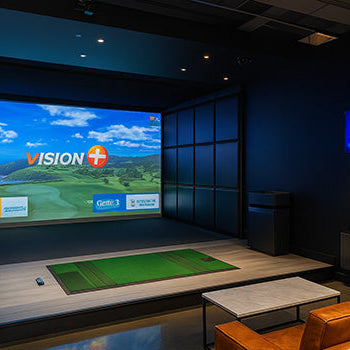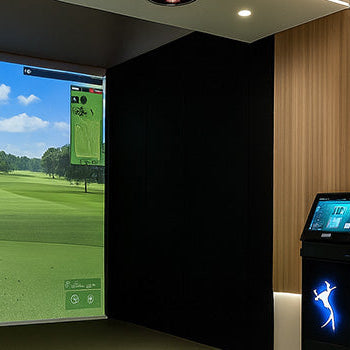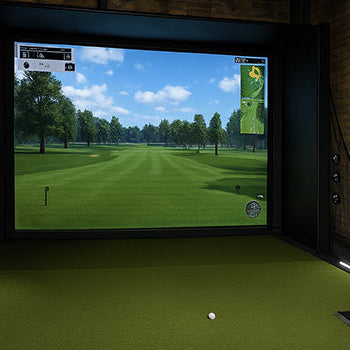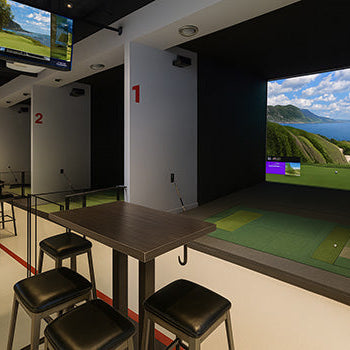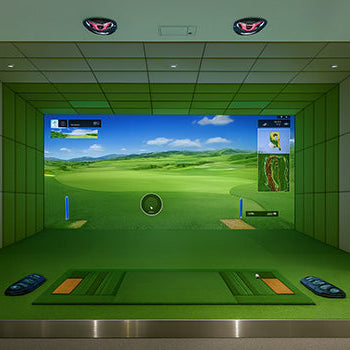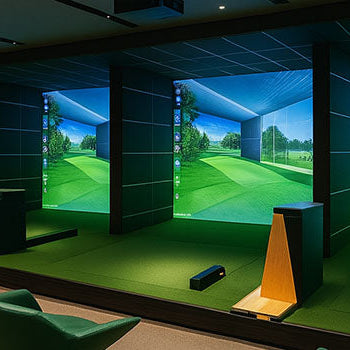Ever tried putting on your living room rug with a mug as the hole? It’s funny until you realise golf simulators took that concept and turned it into a serious training tool. Yes, you can putt in a golf simulator, and while it’s not exactly like the course, it’s closer than you’d think. With today’s tech, you can sharpen your short game without even stepping outside. Let’s break down how it works, and how to make the most of it.

Yes, You Can Putt... But It's Different from Real Golf
Putting in a simulator? Totally doable. But don’t expect the same feel as real grass underfoot or that natural break you’ve learned to read over time. Golf simulator putting is more about precision, data, and consistency than instinct and green-reading feel.
That said, it’s a great way to fine-tune your technique, especially if you’re short on time or stuck indoors on a rainy weekend.
For many golfers, simulator putting helps eliminate bad habits and build confidence on the greens. But to get real results, you need to know what you’re working with.
How Simulators Handle Putting
So, how does putting work on a golf simulator?
You hit your putt from a mat, and the system uses either high-speed cameras, infrared sensors, or pressure plates to track the ball’s movement. It reads the ball’s launch direction, speed, and path within the first few feet.
Then the simulator software takes over, calculating where the ball would end up on a virtual green.
The good ones are surprisingly accurate, especially when paired with quality putting mats.
The Challenges of Simulating Short, Slow Shots
Here’s where it gets tricky.
Short putts don’t generate much ball speed or spin, which makes them harder for sensors to track accurately. That’s why a slow 3-footer sometimes “misses” the hole onscreen, even when it felt dead-centre off the face.
Low-speed shots are the simulator’s biggest blind spot.
It’s not a deal-breaker, but it helps to know where the tech might trip up.
Why Putting is Often Considered the Least Realistic Part of Simulation
Let’s be real: putting in a simulator doesn’t feel like sinking a pressure 6-footer on real turf.
There’s no grass grain, no subtle slope beneath your feet, and no tactile feedback like you’d get from natural greens.
That’s why many golfers say simulator putting feels the least authentic, even on the most expensive setups.
Still, for building muscle memory and working on stroke mechanics, it holds solid value.
How It Works: The Technology of Simulator Putting
Understanding the tech behind putting in simulators helps you set the right expectations, and use it properly.
Let’s walk through how it actually functions behind the scenes.
Hitting from the Mat to the Screen
Most systems have you putt from a hitting mat aimed at a screen.
You don’t need to strike it hard, just like on a real green. But you do need a steady hand, because the system watches closely.
As soon as the ball moves, sensors capture launch speed, angle, and direction. That’s how the simulator figures out where the ball would go in the virtual world.
The first few inches of the roll are everything.
Reading the Virtual Green: Break, Elevation, and Stimpmeter
Good simulators replicate real green conditions surprisingly well.
You’ll see 3D visuals showing slope, elevation changes, and even green speed, often calibrated using the Stimpmeter rating.
Want to practice downhill left-to-right breakers on a lightning-fast green? You can.
The better the software, the more realistic your reads. It won’t replace real-world green-reading, but it’ll get you close.
The Importance of Aim and Speed Control
This part is crucial.
Even in the virtual world, you still need good aim and pace. If your putt is offline or under-hit, the simulator won’t forgive you.
Luckily, most systems give immediate feedback, showing whether your stroke path was straight, if the ball launched offline, or if your pace was off.
It’s like having a putting coach in your screen.

Automatic Putting Settings: The Faster Way to Play
Don’t feel like grinding over every 4-footer indoors? You’re not alone. That’s why most simulators include auto-putt options to keep the pace moving.
What is "Auto-Putt" or a "Gimmie"?
Think of auto-putt like a digital handshake. If you’re close enough to the hole, the system gives you the benefit of the doubt and moves on.
A “gimmie” is even more generous, usually set at 3 feet or less.
It’s a feature many players use when they’re playing full rounds indoors, especially in social settings.
How Concession Settings Work (e.g., inside 10 feet is a 2-putt)
Some systems use preset putting rules, like “anything inside 10 feet counts as two putts.”
That may sound strange, but it’s designed to keep rounds flowing and avoid over-reliance on imperfect short-putt tracking.
You can often tweak these settings to match your skill level or preference.
It’s all about balancing realism with speed.
The Pros and Cons of Skipping the Putting Process
Skipping putting saves time, and sometimes sanity.
But if you’re using a simulator to train, rather than just play, skipping the putts means skipping a chance to get better.
It’s a trade-off: convenience vs. skill-building. Choose based on your goals.
If you're short on time, auto-putt is great. If you're serious about your short game, put in the reps.
Improving the Putting Experience
Want to make simulator putting feel more real? You don’t need a full indoor green, just a few smart upgrades.
Dedicated Putting Mats and Turf
Not all mats are equal. A good golf simulator with putting green uses high-quality turf that mimics a real roll.
Some even have subtle breaks or slope inserts, which make practice more dynamic.
It’s a small change that makes a big difference in feedback and feel.
Cheap mats lead to frustrating putts. Invest in quality if you’re serious.
Specialised Putting Cameras and Sensors
Many top-tier simulators now offer low-speed tracking cameras specifically for putting.
These tools pick up the ball’s movement more accurately, even on delicate strokes. They’re especially helpful for players who like to practice their short game seriously indoors.
If your current setup struggles with putts under 10 feet, this upgrade is worth considering.
Tips for More Realistic Simulator Putting
Want better results? Try this:
-
Use alignment aids on your mat
-
Warm up with a few lag putts to get your feel
-
Stick to a consistent stroke routine, even indoors
-
Keep your setup well-lit and clean for accurate sensor reads
-
Don’t rush, treat each putt like it matters
Treating simulator time like real practice = real improvement.

Should You Practice Putting on a Simulator?
It’s not perfect, but it’s far from pointless. There’s a lot to gain if you use it the right way.
What It's Good For: Speed Control and Starting Line
Practising on a simulator is fantastic for developing speed control and improving your start line.
The data shows whether your stroke was straight, if you pushed it, or hit it too soft. Over time, that feedback helps refine your tempo and distance judgment.
It’s a consistent way to groove your stroke indoors.
What It Can't Replicate: Green Reading and Feel
But let’s not sugarcoat it, it still can’t teach you how to read real greens.
There’s no wind, no grain, no foot traffic marks. And there’s definitely no substitute for walking around a putt and feeling the slope under your shoes.
Still, as a year-round tool to build putting consistency, it’s one of the best indoor options available.
